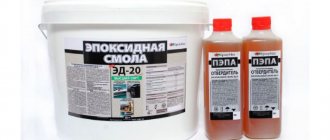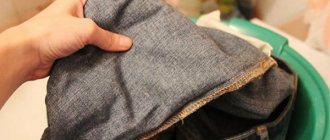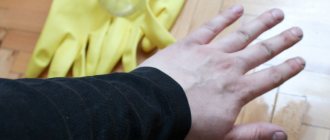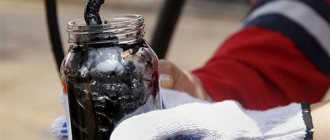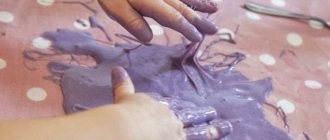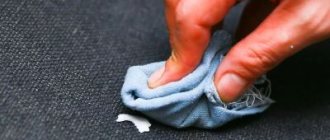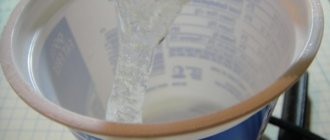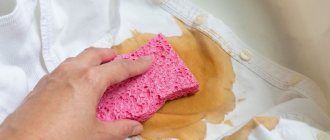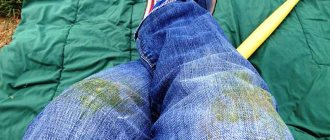Removing resin from clothes is not an easy task. Due to its complex composition, the resin penetrates deeply into the fabric and hardens into its fibers. And if the crust from the surface of the material can be removed mechanically, then it will be more difficult to remove the remaining greasy stain.
Removing a tar stain requires several stages.
In this article, we have prepared for you an overview of effective ways to deal with resin stains from spruce, pine and other trees. Read also how to deal with traces of tar and other types of resin.
Temperature effect
To get rid of the viscous substance, you can do without the use of aggressive chemicals. Using high or low temperatures, as is the case with glue removal, will help.
- Cold. At low temperatures, the resin freezes and becomes brittle. Pack jeans in a plastic bag. Place clothes in the freezer for at least 1.5 hours. To speed up the process, you can add ice cubes to the underside of your jeans by placing them in a separate bag. It is important not to wet the fabric. Take out the frozen item and beat the area with the resin well - it will crumble and flake off easily. To completely remove the frozen mass, you can use a brush.
- Hot processing . The high-heat method can quickly remove fresh resin stains. Place a piece of board wrapped in cloth or napkins under the inner lining. Use an iron set to medium heat. Place napkins, toilet paper or a clean cloth on both sides of the dirty area. Pat this area. During the ironing process, the resin will begin to melt and transfer to the substrate. Change the napkin. Repeat until the stain is completely removed.
Using any of these methods, you can finally get rid of the sticky residue. However, there is a possibility that the resin will no longer be on the jeans, but a stain will remain on the stained area. It can be removed by washing with soap, using improvised means, or dissolving it with special preparations.
Removing stains when washing
After preliminary preparation, contamination can be removed by washing. The main thing is to choose effective means that can remove it .
Vegetable oil
This affordable product is considered a gentle remedy. Mode of application:
- Apply a small amount of oil to the resin.
- After 15 minutes, the surface is cleaned with soapy water and a brush.
- The item is washed in the usual way.
Laundry soap
The cleaning procedure is simple and boils down to the following steps:
- The fabric is moistened with warm water.
- The resin is rubbed with soap.
- The fabric is kept in this state for a quarter of an hour.
- After the specified time, the item is rinsed.
- The procedure is repeated again.
Lemon acid
Under the influence of acid, the substance softens.
The cleaning procedure is carried out according to the following scheme:
- Citric acid is mixed with water in equal proportions.
- The resulting mass is applied to the contamination.
- Ten minutes later, the clothes are washed in an automatic machine.
Dishwashing liquid
In the fight against resin, household chemicals give good results. For example, the well-known Fairy. It contains components that can dissolve organic contaminants.
Stages of using the product:
- A few drops of the substance are applied to the resin.
- After 15 minutes the item is rinsed.
- Jeans are washed using washing powder.
Solvents
To remove severe stains, the housewife has to use more aggressive substances. The most effective solvents include gasoline, turpentine and acetone.
Important! Solvents can cause jeans to lighten. Test their effect on an inconspicuous area.
The stain removal process can be divided into several stages:
- Soak a cotton swab in an organic solvent.
- Treat areas with tar stains.
- To completely remove the sticky substance, wash the clothes.
A mixture of turpentine, ammonia and starch
A magic mixture that will remove any stains, including tar on jeans.
- Prepare a solution of turpentine and ammonia. Mix both components in a 1:1 ratio.
- Add starch to the solution and mix the mixture. The result should be a thick paste that should be applied to the stains.
- You will have to wait about an hour for the product to work on old stains. After this, shake the starch and wash the jeans.
How to scrub with special compounds?
Some household chemicals can help cope with the problem . Their use should take into account the specifics of the denim material.
Strong reagents can dissolve not only the resin, but also the coloring pigment of denim pants, and even the fabric itself, so their use is very limited. Such drugs should be used only in extreme cases, given the risk of damage to your favorite pair of trousers.
The safest solvents for jeans are white spirit and refined gasoline. You should also not forget about good stain removers that will help remove remaining traces of resin.
Stain remover
This option is suitable for removing fresh contaminants that have not been deeply absorbed into the fibers and have not hardened. Stain removers in gel form are easiest to apply and distribute more evenly.
You can leave the composition on jeans for a quarter of an hour or a little more. As soon as the resin begins to be removed, it is removed. After this, the jeans are washed.
Stain removers are represented on the household chemicals market in a wide range and price categories. For example, the price for a small package of Cinderella product is from 45 rubles.
White Spirit
White spirit solvent comes to the rescue when removing a wide variety of stains . One application is to remove tar.
To apply the effect, you will need a sponge or napkin, which must be soaked in white spirit and applied to the stain. After the resin becomes softer, it is removed. Jeans are washed.
The cost of the solvent is affordable, from 80 rubles per liter bottle.
Petrol
Refined gasoline or kerosene are often used household products . You can try to use them to remove resin. Gasoline is applied to a sponge and applied to the stained area.
Price - about 150 rubles per liter container.
First step
Before you wash the resin at home, you need to prepare the item.
First, get rid of the resin crust mechanically. Using a sharp object, such as a knife, carefully scrape off the resin.
Then, to make it easier for you to remove small particles, put the item in the freezer for several hours. Once the resin has set, remember the cloth and scrape off any remaining substance.
After freezing, the resin becomes brittle - just rub the stain with a brush, and the remaining resin crust will easily fall off.
Pre-cleaning
First, mechanically clean your clothes. To avoid damaging the fabric, it is better to use a wooden or plastic spatula. Use it to scrape off the sticky substance that is stuck to the fabric. It is better to avoid using sharp objects as they can damage your jeans.
Important! Clean only at home, using clean tools. Resin is a sticky substance and other things, including dust and debris, will quickly stick to it. In this situation, it will be much more difficult to remove contamination.
When the bulk of the contamination has been removed, choose the method in which you will clean the resin from the jeans.
Recommendations
Before you begin removing tar stains, here are some helpful tips:
- To prevent the stain from spreading across the fabric, moisten the area around the stain with water and sprinkle with talcum powder or starch. This will allow the stain not to smudge and remain within its boundaries;
- The resin is always removed from the wrong side of the product. Place a plain napkin (made of fabric or paper) on the front side;
- to remove resin from a small area, use a pipette or a cotton swab to apply the product;
- It will be easier to remove the resin if you clean the stain from the edges to the center.
Removing stains and odors after cleaning
After you get rid of the resin, any item needs to be sent to the wash. Use laundry soap or liquid powders, if the fabric allows, then with bleaching properties. Adding a scent conditioner will help.
A simple trick that will protect the cleaned item from streaks: pour regular milk into a bowl and soak the fabric for 2-3 hours. After soaking, the fabric should be rinsed well and dried in a suitable manner.
Don't be careless about tar stains. The faster you take on the problem, the higher the likelihood of success. A rational sequence of actions will save expensive clothes, shoes and camping equipment.
Available means
So, what can you use to remove resin? If a store-bought stain remover doesn’t do the job, improvised products come to the rescue, which are found in almost every home.
Alcohol
A common way to remove tar from clothes is to use alcohol.
This method can be used to remove resin from jeans, pants, jackets or other clothes made of thick fabric. Please note that alcohol can corrode some dyes, so test it on an inconspicuous area before starting the procedure. Alcohol is not recommended for items made from thin fabrics.
An iron will help remove resin from clothes. The method is suitable for delicate fabrics (chiffon, silk).
Place cloth napkins (not colored ones) on the back and front sides of the stain and iron several times. At high temperatures, the resin will begin to melt and gradually seep onto the napkins. Change the wipes several times, continuing to run the iron over the stain until it is completely gone. After the procedure, wash the item as usual.
This method is suitable for colored fabrics , since, unlike alcohol or solvent, exposure to high temperature will not damage the color of the product.
The iron will help remove stains from wood and epoxy resins.
Solvents
Solvents are often used to remove resin from clothes. You can also use refined gasoline (for lighters), acetone or nail polish remover.
Acetone and white spirit are suitable for removing stains from plain clothes. White spirit will cope with tar, wood and epoxy resin. Do not use acetone on silk acetate.
For colored items, nail polish remover is better - it is less aggressive for fibers. Gasoline also has a more gentle effect on fabric.
Toluene and toluene-based solvents will help remove synthetic resin stains.
Use solvent carefully to remove resin stains from colored fabrics. Be sure to test the fabric's reaction in an inconspicuous area.
Turpentine
You can use turpentine in combination with starch and ammonia. This method is suitable for delicate fabrics. Prepare a mixture of 1 tbsp. l. starch, 3-4 drops of ammonia and 3-4 drops of turpentine and apply to the stain. After the mixture has dried, scrub the stain with a brush, rinse and wash the item as usual. If necessary, the procedure can be repeated.
Dishwashing liquid
Dishwashing liquid dissolves grease and can easily remove small tar stains.
Rub the stain with dish soap, let it sit for a while, rinse the item in water and wash it in the traditional way.
This method is especially good for woolen items . Pre-treat the stain with vegetable oil, then rub with dishwashing liquid and leave to act for a while. Then rinse and wash the item as usual.
Lemon juice
Oil
If you dare to use oil to remove resin from fabric items, remember that you will have to get rid of the greasy stain. Wash the item with laundry soap or dishwashing detergent. If the fabric allows, you can use alcohol.
Butter will do the job well. Take a piece of oil and work the stain thoroughly. Remove oil with alcohol or dishwashing liquid.
Carbonated drinks
You can remove pine resin (and not only) using carbonated drinks: Coca-Cola, Fanta or Sprite. Apply soda to the stain or completely soak the item in the drink for several hours. After a while, scrub the stain with a brush, and after the procedure, wash the item in the traditional way.
Boiling water
To remove resin from cotton fabric , you can use boiling water. As soon as you take the item out of the freezer, thoroughly pour boiling water over the stain and remove any remaining resin with a napkin. Then wash the item as usual.
Soda, starch
Sprinkle baking soda or starch onto the stain and leave for 1 hour. Then scrub the stain thoroughly with a brush or your hands and wash the item as usual. The method is suitable for delicate fabrics .
Features of removing resin from different types of fabrics
If jeans are made from durable fabrics, then for jackets they use leather, artificial leather, suede, velor, and synthetics. Therefore, before washing the viscous mass of pine from clothes, you need to decide on the composition of the fabric. Only in this case can you choose the necessary remedy.
Warning! Before using bleaches, solvents, or chemicals to remove tar from jeans or a jacket, you need to check that they will not remove the paint. You can check the product from the inside out.
Helpful Tips:
- Delicate fabrics can be washed from the viscous mass of pine wood using vegetable oil and dishwashing detergent.
- It is better to wash jackets made of fur, leather, leatherette with alcohol.
- Turpentine, soap, and alcohol will do an excellent job of removing resin on woolen products.
- Jackets covered with velvet, velor, silk and other delicate fabrics are washed using ether, alcohol, and starch.
- Synthetic fabrics cannot be washed off wood resin using gasoline.

